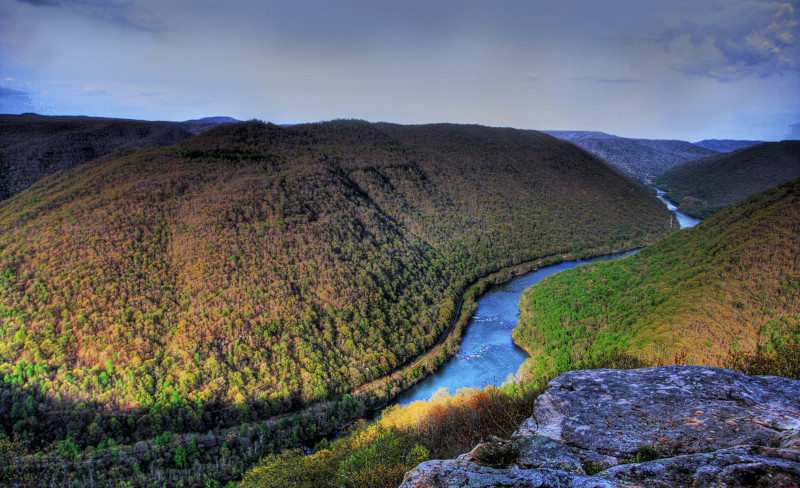New River Facts
- This wonder of Nature, cleverly dubbed the New River, actually bears a potentially deceptive name. That’s due to the presence of a certain amount of controversy surrounding its exact age. Some, but not all, geologists consider it one of the oldest rivers on the entire planet.
- Regardless of its status in that regard, however, this amazing work of geological forces still stands out from many similar features in the region. The body of water’s long been serving as a vitally important corridor for the spreading of flora and fauna through the region.
- Several portions of its length also now hold large man-made dams, for hydroelectricity generation. Some of the surrounding ridges, however, also serve as home to uncommon plants. Thankfully, great care has therefore been taken to preserve these many native species.
- Local Native American tribes new of its presence for countless centuries prior to the arrival of European settlers, of course. The first recorded sighting of it by outsiders occurred in 1671. At that time, several members of a fur trading expedition found and explored parts of it.
- Today, local residents greatly enjoy and appreciate its magnificent natural beauty. This further takes many forms. These frequently include such activities as kayaking and rafting. Numerous large, open ledges also dot its length, allowing for the creation of fabulous viewing sites.
- The foundations of the misleading name New River itself remain undetermined with complete certainty. One theory purports that it derives from a word in the language of the local tribes that means new waters. Several differing theories, however, propose other origins.
Related Articles
New River Physical Description
The captivating New River generally does exactly that with those individuals discovering it for the first time. The marvel of geology does so for a surprising variety of reasons, however. That’s true since it impresses the viewer with both its pure beauty and quite respectable dimensions.
While it’s certainly not the longest river in the world, this beautiful flow nevertheless boasts a length that’s quite impressive in its own right. Although it does frequently take a somewhat winding course, the overall length of this peaceful flow of water measures out to approximately 360 mi (580 km).
It also stands out for another reason, as well. The direction of its flow further distinguishes it from the many other rivers in its part of the world. That’s because the wonder’s believed to be the only major river in the entire country in which it appears to primarily flow in a northward direction.
Along its intriguingly wending course, the New River also inexorably cuts its way through numerous gorges. Some of these also have an impressive depth, with the local walls rising as much as 1,500 ft (457.2 m) above the surface of the water. It also boast numerous areas of powerful rapids.
Its depth also varies, in some cases quite extremely. Along most of its course, this characteristic varies, reaching as much as 100 ft (30.5 m). However, in a few sections, this dwindles to no more than a few inches! In areas other than around the rapids, the river typically has a slow, gentle flow.
New River Location, Formation, and Ecology
The controversially-named New River formed in a region of the world already quite well known for its abundance of scenic beauty. This region consists of a long-settled portion of North America. More precisely, the natural marvel formed in the southeast portion of the United States.
There, this remarkable flow of water presently finds its presence restricted to a total of just 3 states. These fortunate locations consist of North Carolina, Virginia, and West Virginia. Coincidentally, the meandering path it takes flows through far corners of all three of these of the regions.
This wonder originates in a portion of the Blue Ridge Mountains located in northwestern North Carolina, themselves part of the Appalachian Mountains. The spot from which it flows, the headwaters, in fact, lies only a short distance from the extremely popular resort town of Boone.
Varying estimates place its time of origin to somewhere anywhere between 10 and 360 million years ago. During this time, the ancient Appalachian Mountains continued their slow yet inexorable push upward. This gradually altered the direction of its flow, and thus shortened its length.
The amazing New River also flows through the very heart of the largest block of relatively unfragmented, mid-latitude forest still remaining in the entire world. This setting serves as home to countless plant varieties, including dozens of different species of trees, largely hardwoods.
Perhaps even more impressively, its banks provide a home to a relatively large abundance of flora, both in numbers of species, and sheer volume, too. This plethora of life includes many uncommon forms of cedars, pines, and sedges. Some of these, in fact, appear nowhere else on earth.
Equally impressive, however, stands the fact that fauna at least equally abounds in the region, partly thanks to its presence. Many of these evolved as endemic, while others migrate along its banks. At least 65 species of mammals live in the region, along with nearly 40 species of reptiles.
The bucolic waters of the meserizing New River also boast at least seven varieties of fish, with an abundant population. Some of these also appear nowhere else on earth. Many types of insects and birds, migratory and otherwise, appear in the region, including the majestic Bald Eagle.
Features Sharing Its Region
Check out our other articles on 3 Astounding Antarctic Whales, Chinese Giant Salamander, Victoria Falls, Oribi, Pink Flannel Flower, Giant Girdled Lizard, Green Milkweed Grasshopper

